F1 upgrades stall as Max wins all in Spain and Canada
Mercedes, Ferrari and Aston Martin were looking for an upturn from their 2023 upgrades, but none could stop the Verstappen train, says Mark Hughes
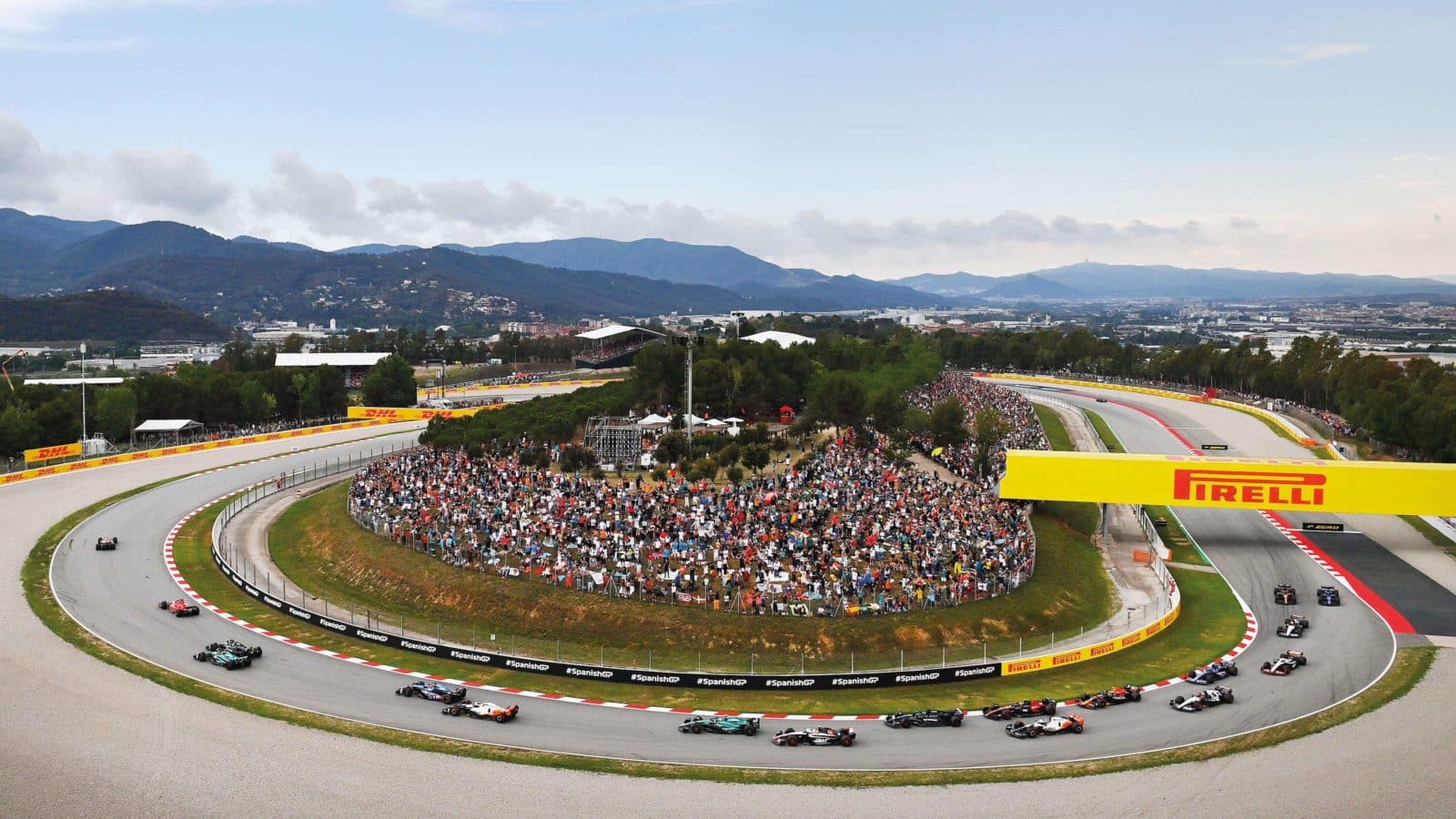
The long, fast turns at Barcelona acted to emphasise Red Bull’s advantage, and Verstappen was unstoppable in Spain
Getty Images
The very different demands of Barcelona’s Circuit de Catalunya and those of Montréal’s Circuit Gilles Villeneuve would be an important litmus test for the three closely matched teams directly behind Red Bull.
Aston Martin, Mercedes and Ferrari have three very different but quite well-matched cars, each with at least one stellar driver. The competitive order between them is shuffled between each race. But the big deficit to the dominant Red Bull had been unchanging in the first six races. Mercedes was the first to introduce a major update of its car in an attempt at closing that gap. This had debuted at Monaco, but Barcelona would be the first realistic test of its effectiveness. Ferrari’s major bodywork upgrade would debut in Barcelona. Aston Martin’s would arrive in Montréal. How would this reset impact upon the order between them and the deficit to Red Bull?
After a quick trip down the coast of southern France and northern Spain, F1 decamped to Barcelona just a day or two after leaving Monaco.
“The loss of the chicane made the last corner a flat-out blast”
Mercedes had ditched the ‘zero-sidepod’ concept of the last two years, with a more conventional-looking bodywork and a heavily revised front suspension featuring a lot of anti-dive in its geometry, just like the Red Bull’s. Lewis Hamilton and George Russell had commented in Monaco that the new car had a better front end. Barcelona would be a stern test of its high-speed aerodynamics.
Ferrari had made its distinctive ‘outwashing’ bodywork less extreme, the sidepods slimmer, but with the widest part stretching back further than before. This was claimed to reduce the detachment of the airflow around the sidepods as it makes its way to the critical gap between the rear wheels and diffuser. The tunnel numbers promised a significant increase in downforce but, as Carlos Sainz warned, long fast corners like those of Barcelona did not suit the car.
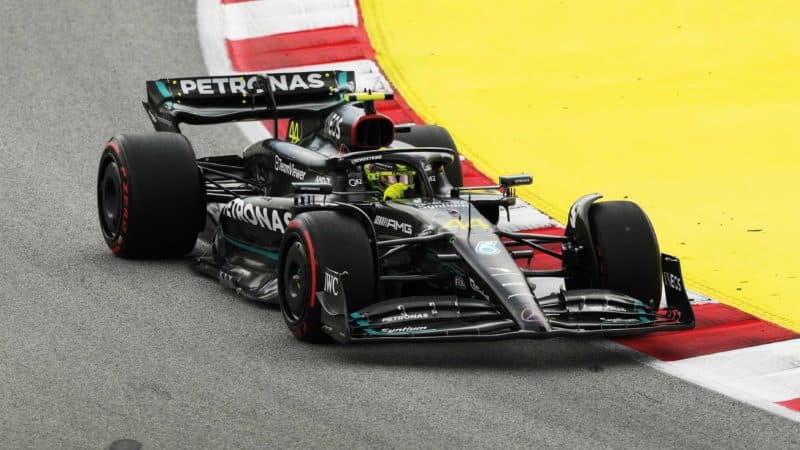
Mercedes ditched its ‘size-zero’ sidepod concept in favour of something more traditional, but it still couldn’t stop Verstappen
Getty Images
Although hosting the seventh round of the championship, the Circuit de Catalunya was actually the first conventional track the cars have run on this year, given Bahrain’s heavy emphasis on rear-tyre temperatures, the street layout of the others and the cancellation of Imola. The aerodynamic demands are extreme. Fears it would only exaggerate Red Bull’s advantage proved very well-founded, as Max Verstappen cruised to a dominant victory from a dominant pole, in the lead start-to-finish – even through the pit stop phase – and fastest lap, too.
But while that part of the equation was quite simple, there was a tyre code to crack first – and not everyone was able to do so. The deletion of the previous slow chicane from the end of the lap made the final corner a close to flat-out seventh gear blast – but a long one. This in combination with the other long, fast corners around the track gave the front tyres almost no respite in the race. The degradation rate was very high, imposing a two-stop strategy on everyone.
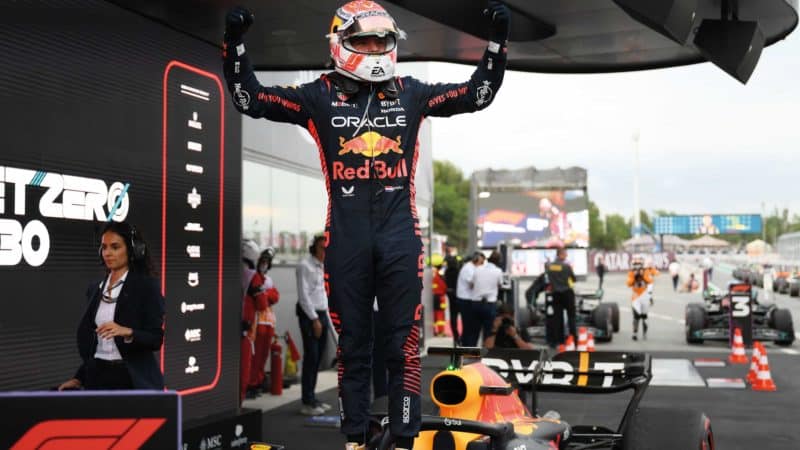
Another victory for Max Verstappen at Barcelona-Catalunya
That would have been challenge enough – and wasn’t so very different to how Barcelona has always been, simply more extreme – but it conflicted with the tyre challenge of qualifying. There, a very cool track took the tyres out of their temperature window and getting the fronts to turn on in time for the beginning of the qualifying lap without the rears overheating by the end was difficult. Some cars and drivers did it better than others, and those which did it well were not necessarily the usual front-runners.
Verstappen took pole by the biggest margin of his season so far, but team-mate Sergio Pérez could not get the tyres working over one lap and was almost 0.6sec off Verstappen’s pace, which was not enough to see him graduate from Q2. Similarly George Russell was experiencing difficulty with his tyre temperatures and would line his Mercedes up behind Pérez, in 12th. Charles Leclerc’s Ferrari had difficulties other than tyres and was unable to even make it out of Q1, only 19th fastest of the 20 cars. A mechanical problem at the rear of the car was suspected. Carlos Sainz in the sister Ferrari – with heavily upgraded bodywork – switched on its tyres just fine and qualified on the front row, albeit around half-a-second adrift of Verstappen. But the biggest beneficiary of the anomalous tyre situation was McLaren, with a car that for reasons even the team doesn’t understand, is always good at generating front tyre heat for qualifying. So you didn’t have to push so hard on the out-lap to bring the fronts in that you overworked the rears. This helped the team get both cars through to Q3, where Lando Norris then went a great third-quickest, falling just hundredths short of the front row.
“Charles Leclerc had looked very close on pace to Verstappen”
The contrasting tyre challenges of Saturday and Sunday gave a completely different competitive order behind Verstappen. Even if Norris had not taken his front wing off on the first lap against the back of Lewis Hamilton’s Mercedes, he wouldn’t have had the pace to run anywhere near where he’d qualified. Sainz, after fighting out the first corner with Verstappen, faded as the pace the Ferrari’s front-tyre temperatures dictated meant he was easy meat for Hamilton and subsequently the recovering Russell and Pérez. So, Mercedes took a promising 2-3, albeit over 20sec behind Verstappen despite a more favourable tyre strategy (see Strategy).
For Aston Martin, Barcelona was a low-key race. Lance Stroll and Fernando Alonso were sixth and seventh across the line, over a minute behind the winner. But there was a big upgrade coming for Canada. As with the Mercedes and Ferrari updates, the most visually obvious were the new sidepods, with a deeper undercut at the front and a deeper, narrower channel cut through the upper surface, all in an attempt at speeding up the airflow to the back of the car.
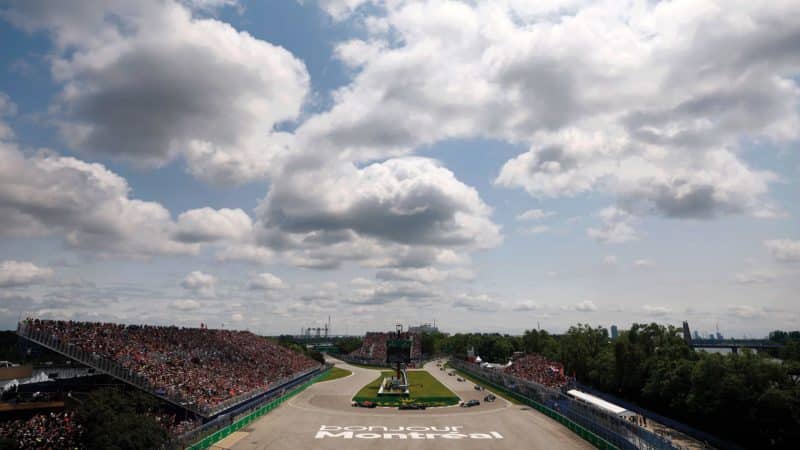
The changing conditions of Montréal produced something more akin to a contest, even if most of the action happened behind the leader.
Montréal, a circuit of short, slow corners and long straights, is less demanding of high-speed downforce than Barcelona and Ferrari was quite excited about its prospects there, given its car’s strong straight-line speed. This was borne out in the Friday practices where Charles Leclerc looked tantalisingly close on pace to Verstappen. But that was in the dry. Qualifying was wet, but with rapidly changing track conditions, alternately drying then wetter again, with wild variations in grip from one lap to the next. Timing and confidence was everything and Verstappen put his Red Bull on pole by another season-best margin, over 1.2sec from that other wet-weather ace Nico Hülkenberg. The Haas driver was subsequently penalised three places for not having slowed enough for a red flag – putting Alonso’s Aston Martin on the front row ahead of an all-Mercedes row two, Hamilton ahead of Russell. The Ferraris were just not as competitive in the wet, there was some uncertainty in its pit counter communications with the drivers and only Sainz made it into Q3, eighth fastest. He was subsequently penalised for impeding and so would start 11th, one place behind team-mate Leclerc.
In the dry but overcast cool of race day Verstappen took an immediate lead, Hamilton out-dragged Alonso off the grid to go second and Russell followed on close behind the Aston. The Ferraris were mired in the midfield on account of their poor grid positions and unable to pass the group of slower cars ahead of them because of the ‘DRS train’ phenomenon.
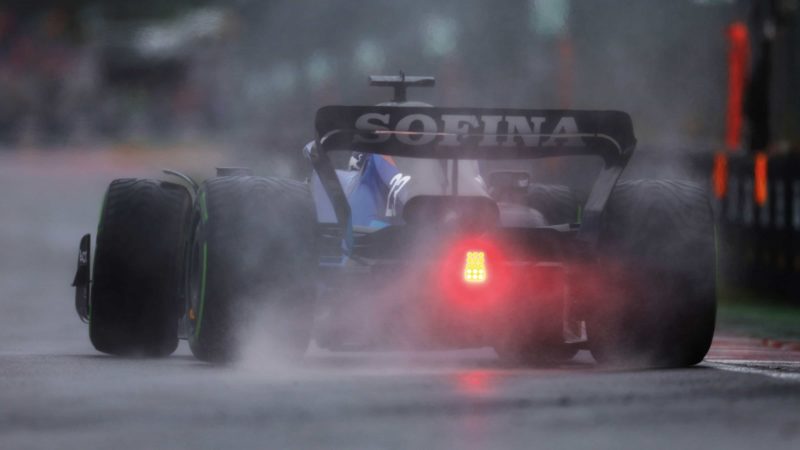
Alex Albon slides to a fine seventh for Williams.
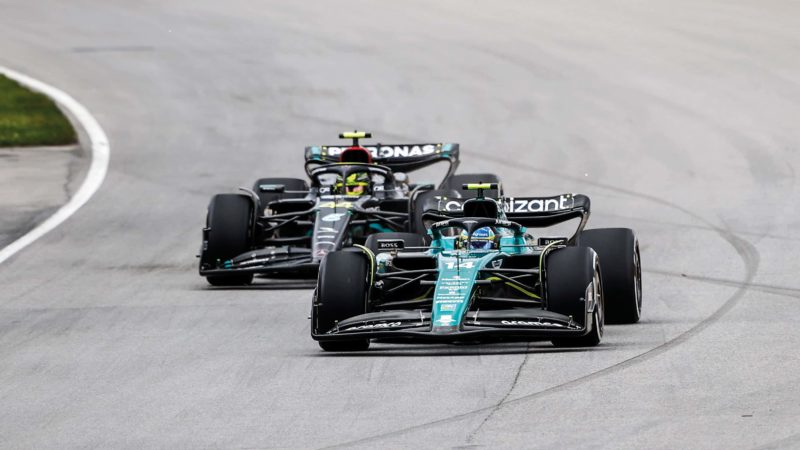
Alonso vs Hamilton in a slipstreamer
This stalemate was only broken by a safety car on the 12th lap. This was to clear up debris on track from Russell having hit the Turn 8 wall, having just misjudged how he hit the kerb in his chase of Alonso. Verstappen, Hamilton and Alonso used the safety car period to make their first tyre stops – as did the cars in the DRS train which had been slowing the Ferraris. By staying out, Ferrari was able to get Leclerc and Sainz past that group, knowing they had the pace in clear air to easily clear the midfielders before needing to stop. This put the Ferraris on a one-stop strategy, while the early stops of Verstappen, Hamilton and Alonso put them on a two. Upon the restart Verstappen pulled clear once more but, just as in the opening stint, this was not the level of dominance usually seen from him. In the cool conditions he was having difficulty in generating enough heat in the front tyres. He still had way better traction than the chasing Mercedes though, as Hamilton observed. “His rear end, how he can get the power down, was just in a different league.” The Merc’s traction shortfall meant he was vulnerable to Alonso out of the hairpin onto the long back straight and not long after the restart the Aston, aided by DRS, sailed past for second.
“Verstappen took a Senna-equalling 41st career victory”
Alonso was able to track Verstappen, but not really close on him. He was then delayed by an instruction to lift and coast for a few laps to save fuel (needlessly, as it later turned out, for there was a glitch in the data). This allowed Verstappen to stretch the gap to 8-9sec, but at no stage did he feel comfortable. This was the Red Bull’s least competitive showing of the season. “It was not a very straightforward race because the tyres were not really getting in their window,” he said. “It was very cold today compared to Friday and we were sliding around quite a bit. But yeah, we made it work.
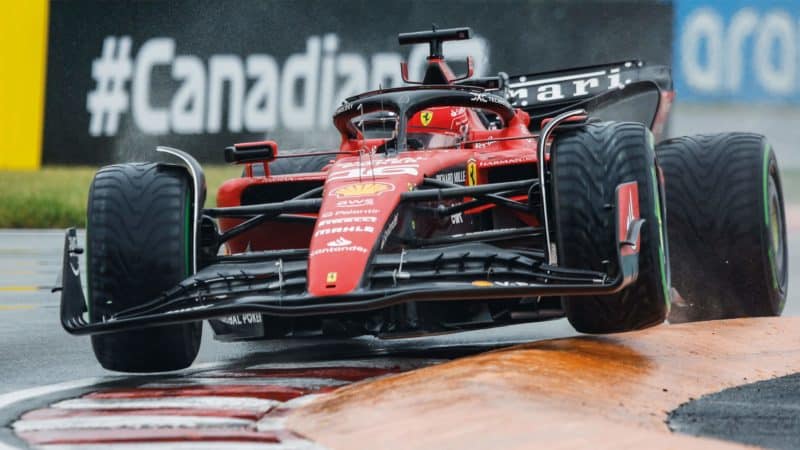
Had it stayed dry, Ferrari stood a good chance of challenging Red Bull, but the rain undid the team
DPPI
“Normally it’s all about tyre management, right? But today was definitely more about pushing. But sometimes it was just going up and down a lot in lap time. So then sometimes you couldn’t actually push to the limit, because you didn’t know what you were going to get. So, for me, on the hard tyre, it was quite a bit of a struggle, and then on the medium, I wanted to open up that gap a little bit more. So then, of course, at one point, you’re seeing, like 10-15 laps to go and you have a good gap, you don’t want to take too many risks. It’s probably not flat-out pushing, but you cannot relax too much because then you lose the temperature in your tyres.”
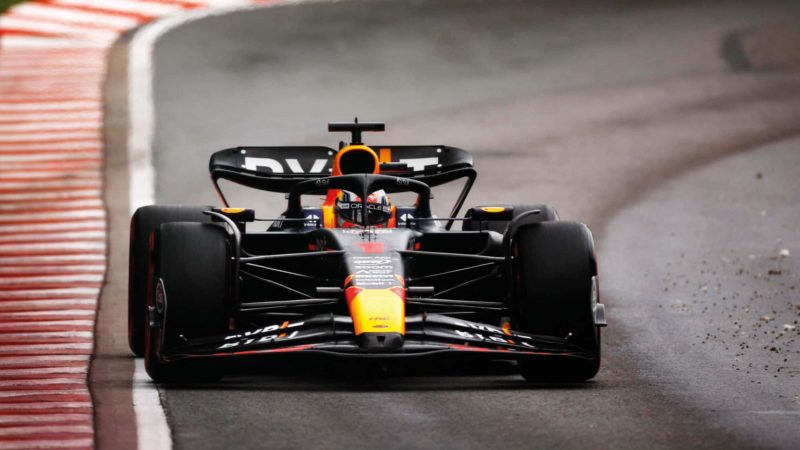
Milestones galore: Verstappen matched Senna’s tally of 41 wins in Canada, while notching 100 for his team and 200 for designer Adrian Newey
But even after being given the all-clear on his fuel, Alonso’s last few laps were spent containing a renewed Hamilton challenge rather than being able to threaten Verstappen, who duly took a Senna-equalling 41st career victory. This also marked the 100th grand prix win for Red Bull and the 200th for its technical guru Adrian Newey. Alonso finished just 9sec behind the winner, Hamilton 14sec, Leclerc 18sec. The Ferrari had been as quick as the Aston and Mercedes once clear of the traffic. Most previous races this season, Red Bull had won by between 20-30sec.
So the gap had closed to Red Bull – but probably largely because of the particular circumstances of Montréal rather than any transformational effect of upgrades from Aston, Mercedes or Ferrari. The Verstappen steamroller continued for now.
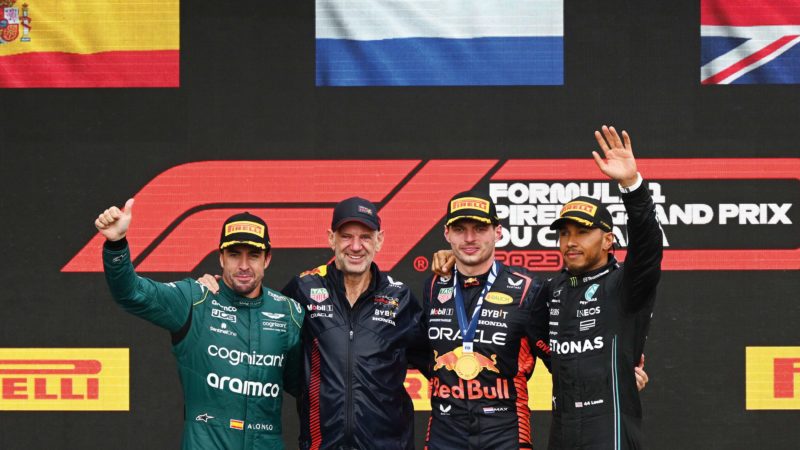
A podium full of champions in Canada, plus the genius of Newey
Getty Images
 Catalunya – Grand Prix Circuit
Catalunya – Grand Prix Circuit
Select a year
Type
Permanent road course
Length
2.905 (Miles)
Change
Turn 10 reprofiled
Fastest Race Lap
Max Verstappen (Red Bull RB16B-Honda), 1m18.149, 136.277 mph, F1, 2021
Fastest Qualifying Lap
Lewis Hamilton (Mercedes-Benz F1 W12 E Performance), 1m16.741, 136.277 mph, F1, 2021
Type
Permanent road course
Length
2.892 (Miles)
Change
Chicane built at the penultimate corner
Fastest Race Lap
Valtteri Bottas (Mercedes-Benz F1 W11 EQ Performance), 1m15.183, 138.479 mph, F1, 2020
Fastest Qualifying Lap
Valtteri Bottas (Mercedes-Benz F1 W10 EQ Power+), 1m15.406, 138.069 mph, F1, 2019
Type
Permanent road course
Length
2.875 (Miles)
Change
New section built at La Caixa, previous layout retained for motorcycle races
Fastest Race Lap
Giancarlo Fisichella (Renault R25), 1m15.641, 136.831 mph, F1, 2005
Fastest Qualifying Lap
Fernando Alonso (Renault R26), 1m14.648, 138.651 mph, F1, 2006
Type
Permanent road course
Length
2.937 (Miles)
Change
The back straight built to bypass Nissan Esses
Fastest Race Lap
Rubens Barrichello (Ferrari F2003-GA), 1m20.143, 131.929 mph, F1, 2003
Fastest Qualifying Lap
Michael Schumacher (Ferrari F2002), 1m16.364, 138.458 mph, F1, 2002
Type
Permanent road course
Length
2.9497 (Miles)
Change
Temporary tyre chicane inserted before Nissan Esses for car races
Fastest Race Lap
Michael Schumacher (Benetton B194-Ford), 1m25.155, 124.701 mph, F1, 1994
Fastest Qualifying Lap
Michael Schumacher (Benetton B194-Ford), 1m21.908, 129.645 mph, F1, 1994
Type
Permanent road course
Length
2.9497 (Miles)
Change
Original Grand Prix circuit
Fastest Race Lap
Michael Schumacher (Benetton B193B-Ford), 1m20.989, 131.116 mph, F1, 1993
Fastest Qualifying Lap
Alain Prost (Williams FW15C-Renault), 1m17.809, 136.474 mph, F1, 1993
